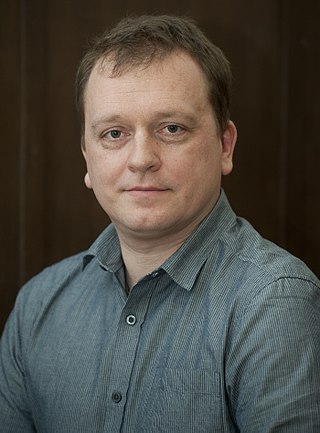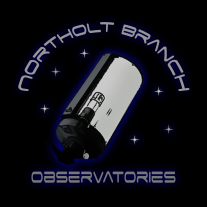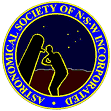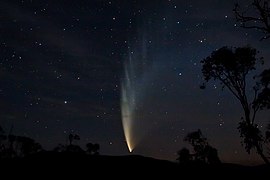
Amateur astronomy is a hobby where participants enjoy observing or imaging celestial objects in the sky using the unaided eye, binoculars, or telescopes. Even though scientific research may not be their primary goal, some amateur astronomers make contributions in doing citizen science, such as by monitoring variable stars, double stars, sunspots, or occultations of stars by the Moon or asteroids, or by discovering transient astronomical events, such as comets, galactic novae or supernovae in other galaxies.

Charles Thomas Kowal was an American astronomer known for his observations and discoveries in the Solar System. As a staff astronomer at Caltech's Mount Wilson and Palomar Mountain observatories between 1961 and 1984, he found the first of a new class of Solar System objects, the centaurs, discovered two moons of the planet Jupiter, and discovered or co-discovered a number of asteroids, comets and supernovae. He was awarded the James Craig Watson Medal for his contributions to astronomy in 1979.

Jean Mueller is an American astronomer and discoverer of comets, minor planets, and a large number of supernovas at the U.S. Palomar Observatory in California.

Gordon John Garradd is an Australian amateur astronomer and photographer from Loomberah, New South Wales. He has discovered numerous asteroids and comets, including the hyperbolic comet C/2009 P1, and four novae in the Large Magellanic Cloud. The asteroid and Mars-crosser, 5066 Garradd, was named in his honour.

Siding Spring Observatory near Coonabarabran, New South Wales, Australia, part of the Research School of Astronomy & Astrophysics (RSAA) at the Australian National University (ANU), incorporates the Anglo-Australian Telescope along with a collection of other telescopes owned by the Australian National University, the University of New South Wales, and other institutions. The observatory is situated 1,165 metres (3,822 ft) above sea level in the Warrumbungle National Park on Mount Woorat, also known as Siding Spring Mountain. Siding Spring Observatory is owned by the Australian National University (ANU) and is part of the Mount Stromlo and Siding Spring Observatories research school.
Leuschner Observatory, originally called the Students' Observatory, is an observatory jointly operated by the University of California, Berkeley and San Francisco State University. The observatory was built in 1886 on the Berkeley campus. For many years, it was directed by Armin Otto Leuschner, for whom the observatory was renamed in 1951. In 1965, it was relocated to its present home in Lafayette, California, approximately 10 miles (16 km) east of the Berkeley campus. In 2012, the physics and astronomy department of San Francisco State University became a partner.

The Panoramic Survey Telescope and Rapid Response System located at Haleakala Observatory, Hawaii, US, consists of astronomical cameras, telescopes and a computing facility that is surveying the sky for moving or variable objects on a continual basis, and also producing accurate astrometry and photometry of already-detected objects. In January 2019 the second Pan-STARRS data release was announced. At 1.6 petabytes, it is the largest volume of astronomical data ever released.
Robert Owen Evans, OAM was a minister of the Uniting Church in Hazelbrook, New South Wales and an amateur astronomer who holds the record for visual discoveries of supernovae (42).

Krisztián Sárneczky is a Hungarian teacher of geography and prolific discoverer of minor planets and supernovae, researching at Konkoly Observatory in Budapest, Hungary. He is a board member of the Hungarian Astronomical Association (HAA) and member of the American Association of Variable Star Observers, leader of the Comet Section of the HAA, and is a contributor in the editorial work of Hungarian Astronomical Almanach.
Martin P. Mobberley is a British amateur astronomer, author, and former electronics engineer.
William Ashley Bradfield was a New Zealand-born Australian amateur astronomer, notable as a prolific amateur discoverer of comets. He discovered 18 comets, all of which bear his name as the sole discoverer.
LightBuckets is a commercial astronomical observatory formerly located in Rodeo, New Mexico and now located in France, which rents time on its telescopes to customers around the world via a website on the Internet, including amateur and professional astronomers. It is an online astronomy platform with live-views, and hosts an image gallery of astronomy images. Recognized scientific uses include the confirmation of supernova and discovery of asteroids.
Thomas Boles is a Scottish amateur astronomer, discoverer of astronomical objects, author, broadcaster and former communications and computer engineer, who observes from his private "Coddenham Observatory" in Coddenham, Suffolk, United Kingdom. He is known for having discovered a record number of supernovae. The main-belt asteroid 7648 Tomboles is named in his honor.

Puckett Observatory is a private astronomical observatory located in the state of Georgia. It is owned and operated by Tim Puckett. Its primary observation goals are the study of comets and the discovery of supernovae. To facilitate the latter goal it sponsors the Puckett Observatory World Supernova Search whose astronomers have discovered 369 supernovae.

Sutherland Astronomical Society Incorporated (SASI) is an amateur astronomical society based in the Sutherland Shire, in the southern suburbs of Sydney, Australia. It operates the Green Point Observatory, it is one of the two founding organizations of the National Australian Convention of Amateur Astronomers, and its members have discovered two comets and two novae.
The Astronomical Society of South Australia (ASSA) was founded in 1892 and is the oldest society of its kind in Australia. It is the only representative body for amateur astronomy in the state of South Australia. It holds regular general monthly meetings, frequent meetings for members of specialised groups and has available two observatories, one with a 300mm telescope at The Heights School within easy reach of Adelaide and used primarily for public viewing, and a second at Stockport with 500mm and 450mm telescopes presently in service and a larger 36-inch instrument currently being considered.
The All Sky Automated Survey for SuperNovae (ASAS-SN) is an automated program to search for new supernovae and other astronomical transients, headed by astronomers from the Ohio State University, including Christopher Kochanek and Krzysztof Stanek. It has 20 robotic telescopes in both the northern and southern hemispheres. It can survey the entire sky approximately once every day.

The Northolt Branch Observatories is an astronomical observatory located in London, England. NBO collects follow-up astrometry of near-Earth asteroids and other small Solar System objects. It focuses on public outreach, sharing images, videos and information about asteroids on social media.
John Caister "Jack" Bennett, was a South African civil servant and amateur astronomer. His mother was British and his father was from Tasmania. He attended school in Ficksburg and began to work in public service after graduating in 1934, initially in the forestry administration in Elgin before moving to the administration of Transvaal Province in Pretoria. During World War II he served as a soldier in South Africa, Egypt and Italy. In 1974 he retired from the public service. From 1985 he began to suffer from arthritis and soon afterwards his health deteriorated so much that he had to sell his house in Pretoria's Riviera neighborhood and move into a nursing home. He died on 30 May 1990 at the age of 76.
Tenagra Observatory and Tenagra Observatory II are astronomical observatories in Cottage Grove, Oregon and Arizona. The observatories house heavily automated robotic telescopes.













